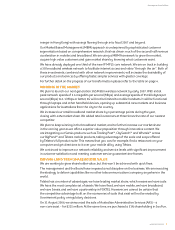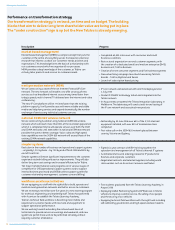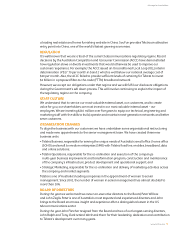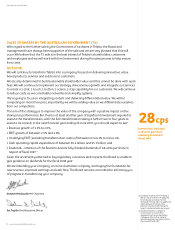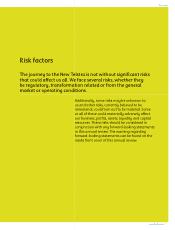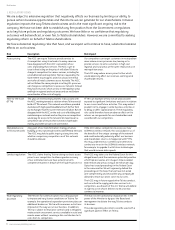Telstra 2006 Annual Report Download - page 16
Download and view the complete annual report
Please find page 16 of the 2006 Telstra annual report below. You can navigate through the pages in the report by either clicking on the pages listed below, or by using the keyword search tool below to find specific information within the annual report.
Labour expense grew 13.1% to $4.4 billion due to:
redundancy expense of $348 million, split between
normal course of business redundancy costs of
$178 million and current year transformation related
redundancy costs of $170 million. These costs were
associated with the reduction of our workforce by
3,859 staff (excluding the impact of the CSL New World
merger in Hong Kong); total workforce now 49,443;
$186 million included in the overall restructuring and
redundancy provision associated with making a further
2,600 staff reductions over the next two years; and
excluding redundancy costs, labour expense was up 1.7%
mainly due to salary increases.
Goods and services purchased grew 12.3% to $4.7 billion due to:
cost of goods sold increased driven by mobile marketing
campaigns;
mobile handsets subsidies increased as we compete
aggressively in the market; and
network payments increased driven by volume increases
of domestic mobile and SMS terminating on other
carriers’ networks.
Other expenses grew 16.0% to $4.4 billion. Excluding
transformation related costs, other expenses grew 12.5% to
$4.3 billion. The main drivers of other expenses include:
maintenance costs associated with the existing 3G
network;
higher consultancy costs due to transformation activities;
increased market research due to a focus on
understanding customer needs; and
costs associated with property rationalisation,
cancellation of server leases, and the decommissioning of
certain IT platforms and operational and business support
systems.
Depreciation and amortisation costs grew by 15.8% to
$4.1 billion as we have accelerated depreciation and
amortisation on our CDMA network, switching systems,
certain business and operational support systems and
related software totalling $422 million. Excluding accelerated
depreciation and amortisation the increase would have
been 3.9%.
•
•
•
•
•
•
•
•
•
•
The increase in total assets of $964 million was mainly
due to the net impact of the following:
a $731 million increase in property, plant and equipment,
following assets acquired in the CSL New World Mobility
merger and additional capital expenditure on our
transformation, offset by depreciation expense;
a $782 million increase in superannuation assets
following recognition of actuarial gains on the Telstra
Superannuation Scheme; offset by
an $859 million decrease in cash and cash equivalents to
pay dividends and interest on our borrowings.
The increase in total liabilities of $1.8 billion was due to:
a $930 million increase in total borrowings to fund our
various working capital and business requirements as part
of transformation and two special dividend payments;
and
an increase of $860 million in other liabilities, such as
trade and other payables following additional accrued
expenditure in the rollout of the wireline and wireless
networks and IT systems.
The decline in free cash ow to $4.6 billion was due to:
a $234 million decline in cash ow generated by our core
business following the decline in our xed line revenues
and higher levels of expenditure as we commenced
our transformation in the second half and increased
marketing activity to drive revenue;
a $164 million increase in tax paid during the year due to
an instalment rate correction by the Australian Taxation
Ofce; and
a $246 million increase in investing cash ows generated
mainly as a result of increased spend on building and
upgrading our networks and systems to improve the
customer experience as a result of our transformation.
We predominantly used our free cash ow to:
pay dividends to our shareholders of $4.9 billion,
representing 40 cents per share (this included two special
dividends totalling 12 cents per share); and
pay nance costs of $940 million to our debt holders.
These payments totalled $5.9 billion, $1.4 billion higher than
our free cash ow. This excess was funded mainly by an
increase in our net debt (borrowings less cash on hand) of
$1.3 billion.
•
•
•
•
•
•
•
•
•
•
Labour 3,858 13.1
Goods and services purchased 4,211 12.3
Other expenses 3,815 16.0
Total operating expenses 11,884 13.8
Depreciation and amortisation 3,529 15.8
Total expenses 15,413 14.2
Current assets 5,582 (703)
Property, plant and equipment 22,891 731
Total non current assets 29,629 1,667
Total assets 35,211 964
Total liabilities 21,553 (1,790)
Net assets/Equity 13,658 (826)
Net cash provided by operating
activities 8,960 (398)
Capital expenditure (4,129) (174)
Free cash ow 5,194 (644)


